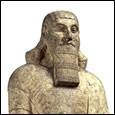The people involved in producing knowledge in ancient Kalhu
Many different types of people were involved in thinking and writing about the world in the Assyrian royal court. The king looked to his scholars TT for advice, ritual TT and healing. The scholars themselves depended on the king for continued patronage and favour. Senior administrators and scribes TT recorded the king's words and composed letters and inscriptions on his behalf. The gods announced their favour or disfavour through ominous TT signs and revelations, which had to be interpreted and responded to.
Kings
Assurnasirpal II (r. 883-859 BC)
King Assurnasirpal II founded the city of Kalhu on the remains of an abandoned town. He laid out the royal citadel TT and created a model of kingship that would be emulated for centuries to come.
Shalmaneser III(r. 858-824 BC)
This king built on his father's work, consolidating the boundaries of empire and finalising his vision for Kalhu. Like Assurnasirpal he commissioned copious inscriptions recording his deeds.
Sargon II (r. 721-705 BC)
Sargon II was the first Assyrian king to have a personal relationship with Nabu, the god of wisdom. Major military victories, attributed in part to his scholars' ability to interpret the gods' wishes, brought Assyria enormous wealth. Amongst his many other big building projects, Sargon oversaw the rebuilding of Nabu's temple Ezida in Kalhu.
Sennacherib (r. 704-681 BC)
This king was more reserved in his support of scholarship, perhaps because of his father Sargon's unexpected death in battle. It was clearly a sign of the gods' displeasure — but why had the scholars not foreseen it? Sennacherib spent little time in Kalhu, preferring his new capital Nineveh PGP .
Esarhaddon (r. 680-669 BC)
King Esarhaddon tried to strike a balance between the attitudes of his royal father and grandfather. While maintaining Nineveh PGP as the capital, he also built a palace in Kalhu, and kept the Succession Treaties there in Nabu's temple Ezida.
Assurbanipal (r. 669-c.630 BC)
This king had a particularly strong personal relationship with Nabu, god of scholarship, because he had trained for the priesthood as a young man. Although his primary focus was Nineveh PGP , he also funded repairs to Ezida in Kalhu. Assurbanipal's ummânu was initially Ištar-šumu-ereš PGP but towards the end of his long reign the system of court scholarship seems to have collapsed.
Deities
Aššur
The supreme god of the Assyrian empire. Aššur was the ultimate divine authority to whom the kings were answerable. His temple was in the ancestral city of Assur but he also had a pedestal in the Temple of Kidmuru in Kalhu.
Ištar
Goddess of sex and war, who had many manifestations in Assyria. In Kalhu Assurnasirpal II built two temples to aspects of this deity: Ištar šarrat niphi ("Blazing Queen") and Ištar bēlet kidmūri ("Mistress of the divine Kidmuri"). In Arbela PGP , she sent revelations to the king through ecstatic TT intermediaries.
Nabu
God of wisdom, who was initially worshipped only by literate, educated men: senior administrators, scribes and scholars. However, over the eighth century BC he became increasingly prominent in Assyrian royal cult. In Kalhu, his temple Ezida was rebuilt and refurbished many times.
Ninurta
God of war, who occupied a splendid temple right next to the royal palace. It was one of the first of Kalhu's buildings to be completed, reflecting this deity's importance for Assyrian kingship. But as mythical rescuer of the Tablet of Destinies TT from the evil Anzu bird PGP , he also had a link to scholarly life.
Scholars and administrators
Scribal families
Two different scribal families dominated intellectual activity in ancient Kalhu. The Ištaran-šumu-ukin family produced several generations of royal scribes and royal āšipu-healers in the 9th and 8th centuries BC. Members of the Gabbu-ilani-ereš family also served as royal scholars. They became particularly prominent in the late 8th and early 7th century when Nabu-zuqup-kenu and his descendants took many senior roles at court.
Scholarly professions
Several scholarly professions are attested at the royal court at Kalhu. The ummânu or Chief Scribe was the king's most trusted scholarly advisor. There were also diviners, healers, and lamenters TT .
The governor TT of Kalhu ran the city and the surrounding province TT . His residence was right next to Nabu's temple Ezida, reflecting his and other senior administrators' trust in the god of wisdom.
Temple staff
The officials of Nabu's temple Ezida ran its daily affairs, ensuring a regular supply of offerings and gifts. The "mayor" TT of Ezida oversaw the annual akītu TT ritual between god and king.
The Palace Scribe
The Palace Scribe was in charge of state archives and one of the king's most trusted officials.
Content last modified: 18 Dec 2019.
Eleanor Robson
Eleanor Robson, 'The people involved in producing knowledge in ancient Kalhu', Nimrud: Materialities of Assyrian Knowledge Production, The Nimrud Project at Oracc.org, 2019 [http://oracc.museum.upenn.edu/nimrud/ancientkalhu/thepeople/]
